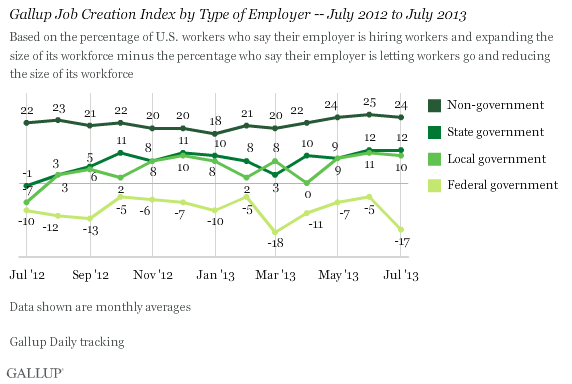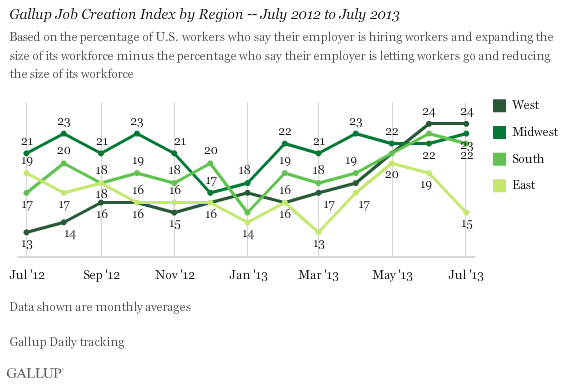PRINCETON, NJ -- Gallup's U.S. Job Creation Index was steady in July, at +21, similar to +22 in June. While non-government workers, as well as state and local government workers, reported little change in net hiring at their workplaces, federal workers reported a significant decline.

Net federal hiring was lower in July, at -17, than it was in the same month a year ago, then registering -10. By contrast, state and local hiring was up in July compared with a year ago. Over the same period, non-government hiring has been relatively flat, generally at or above +20.
Federal Workers See More Shedding of Jobs and Less Hiring
Federal workers were more likely to report that their employer is letting people go rather than hiring in July, by 42% to 25%, resulting in the -17 Job Creation Index score for this group. That is down from a -5 index score in June, and is the lowest since March.
A key explanation for this decline could be federal sequestration. Although these automatic spending cuts went into effect in early March, likely resulting in a heightened perception among federal workers in that same month that hiring was down, it is possible that the pace of furloughs and layoffs increased in July as federal agencies moved to implement the staffing component of budget cuts.
The July decline is due in equal measure to more federal workers saying their employer is letting people go/reducing the size of its workforce and fewer saying their employer is hiring. However, when comparing today's figures with the pre-sequestration figure from the start of this year, reported layoffs (up six percentage points since January) have risen more than hiring (down one point) has declined.

Hiring Rises in the West, Falls in the East
Job creation has surged in the West in recent months and held steady in July at +24. As a result, the West now roughly ties the Midwest for having the highest net hiring figure. At the same time, job growth has slowed in the East.

Over the past year, Gallup finds that hiring has increased the most in the West, rising from +13 to +24, while it has modestly improved in the South. Hiring has varied a bit more in the Midwest -- its current net hiring figure is similar to that of a year ago -- while in the East, hiring is down slightly.
Given the stability or improvement in most regions and employment sectors, the trend in Gallup's overall Job Creation Index in the past year has been positive, now +21, vs. +17 in July 2012. This is also the highest net hiring figure Gallup has found in July of any year since 2008, when the figure was roughly the same.

Index Components Show Little Change Compared With July 2012
July's results are based on 37% of U.S. adult workers saying their employers are hiring and expanding the size of their workforces, and 16% saying their employers are letting workers go and reducing the size of their workforces. U.S. workers' reports of hiring are up slightly over July 2012, while their reports of layoffs are about the same.
Both index components are markedly better than where they stood in July 2009 and July 2010, although the percentage of reported hiring is particularly improved.

Bottom Line
The U.S. jobs market looks fairly flat on the surface, with Gallup's overall Job Creation Index holding steady at a relatively high level in recent months, and up slightly compared with a year ago. However, this masks significant changes in hiring within the federal government, as well as in certain regions of the country. Federal workers report more layoffs and less hiring in July than they did in June, possibly reflecting federal sequestration. Separately, Gallup finds that hiring in the East is down. At the same time, job creation remains relatively strong in the Midwest, and has improved in the South and West -- with the South showing moderate gains since January and the West reporting a more dramatic surge in net hiring over the past 12 months.
Gallup.com reports results from these indexes in daily, weekly, and monthly averages and in Gallup.com stories. Complete trend data are always available to view and export in the following charts:
Daily: Employment, Economic Confidence, Job Creation, Consumer Spending
Weekly: Employment, Economic Confidence, Job Creation, Consumer Spending
Read more about Gallup's economic measures.
View our economic release schedule.
Survey Methods
Results for this Gallup poll are based on telephone interviews conducted July 1-31, 2013, with a random sample of 17,366 adults, aged 18 and older, employed full or part time, living in all 50 U.S. states and the District of Columbia.
For results based on the total sample of employed adults, one can say with 95% confidence that the margin of sampling error is ±1 percentage point.
Interviews are conducted with respondents on landline telephones and cellular phones, with interviews conducted in Spanish for respondents who are primarily Spanish-speaking. Each sample of national adults includes a minimum quota of 50% cellphone respondents and 50% landline respondents, with additional minimum quotas by region. Landline and cell telephone numbers are selected using random-digit-dial methods. Landline respondents are chosen at random within each household on the basis of which member had the most recent birthday.
Samples are weighted to correct for unequal selection probability, nonresponse, and double coverage of landline and cell users in the two sampling frames. They are also weighted to match the national demographics of gender, age, race, Hispanic ethnicity, education, region, population density, and phone status (cellphone only/landline only/both, and cellphone mostly). Demographic weighting targets are based on the March 2012 Current Population Survey figures for the aged 18 and older U.S. population. Phone status targets are based on the July-December 2011 National Health Interview Survey. Population density targets are based on the 2010 census. All reported margins of sampling error include the computed design effects for weighting.
In addition to sampling error, question wording and practical difficulties in conducting surveys can introduce error or bias into the findings of public opinion polls.
For more details on Gallup's polling methodology, visit www.gallup.com.
